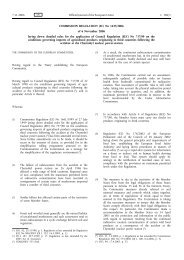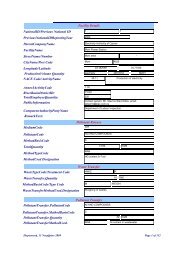Non binding guide to good practice for implementing Directive
Non binding guide to good practice for implementing Directive
Non binding guide to good practice for implementing Directive
- No tags were found...
Create successful ePaper yourself
Turn your PDF publications into a flip-book with our unique Google optimized e-Paper software.
ANNEX B What is vibration?<strong>Non</strong> <strong>binding</strong> <strong>guide</strong> <strong>to</strong> <strong>good</strong> <strong>practice</strong> <strong>for</strong> <strong>implementing</strong> <strong>Directive</strong> 2002/44/EC (Vibrations at Work)B.1 WHAT ISVIBRATION?Vibrations arise when a bodymoves back and <strong>for</strong>th due <strong>to</strong>external and internal <strong>for</strong>ces,Figure B.1. In the case of wholebodyvibration, it may be theseat of a vehicle or the plat<strong>for</strong>mon which a worker is standingthat vibrates, and this motion istransmitted in<strong>to</strong> the body of thedriver.Figure B.1Whole-body vibrationB.2 WHAT IS MEASURED?Vibration is defi ned by its magnitude and frequency.The magnitude of vibration could be expressed as thevibration displacement (in metres), the vibration velocity(in metres per second) or the vibration acceleration (inmetres per second per second or m/s²). However, mostvibration transducers produce an output that is related<strong>to</strong> acceleration (their output is dependent on the <strong>for</strong>ceacting on a fi xed mass within the transducer and, <strong>for</strong> afi xed mass, <strong>for</strong>ce and acceleration are directly related);so acceleration has traditionally been used <strong>to</strong> describevibration.The vibration transducer measures acceleration in onedirection only, so <strong>to</strong> get a more complete picture of thevibration on a surface, three transducers are needed:one in each axis as illustrated in Figure B.2.B.3 WHAT IS FREQUENCY AND FREQUENCYWEIGHTING?Frequency represents the number of times per secondthe vibrating body moves back and <strong>for</strong>th. It is expressedas a value in cycles per second, more usually known ashertz (abbreviated <strong>to</strong> Hz).For whole-body vibration, the frequencies thought <strong>to</strong> beimportant range from 0.5Hz <strong>to</strong> 80Hz. However, becausethe risk of damage is not equal at all frequenciesa frequency-weighting is used <strong>to</strong> represent the likelihoodof damage from the different frequencies. As a result, theweighted acceleration decreases when the frequencyincreases. For whole-body vibration, two different frequencyweightings are used. One weighting (the Wdweighting) applies <strong>to</strong> the two lateral axes: x and y, andanother (the Wk weighting) applies <strong>to</strong> the vertical, z-axisvibration.When considering the risks <strong>to</strong> health from whole-bodyvibration an additional multiplying fac<strong>to</strong>r must beapplied <strong>to</strong> the frequency weighted vibration values. Forthe two lateral axes (x and y) the acceleration values aremultiplied by 1.4. For the vertical, z-axis vibration thefac<strong>to</strong>r is 1.0.B.4 WHAT VIBRATION PARAMETERS ARE USEDFOR EXPOSURE ASSESSMENT?The vibration directive allows <strong>for</strong> two vibration assessmentmethods:• the daily exposure, A(8) - the continuous equivalentacceleration, normalised <strong>to</strong> an 8 hour day, the A(8)value is based on root-mean-square averaging ofthe acceleration signal and has units of m/s²; and• the vibration dose value (VDV) is a cumulative dose,based on the 4 th root-mean-quad of the accelerationsignal with units of m/s 1.75 .Both parameters A(8) and VDV are defi ned in ISO2631-1:1997.Some examples of vibration magnitudes <strong>for</strong> commonhand-held power <strong>to</strong>ols are shown in Figure B.3.Figure B.2 Vibration measurement axes84


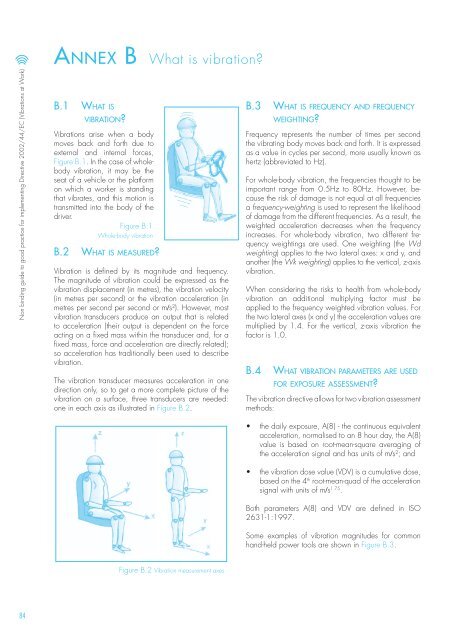




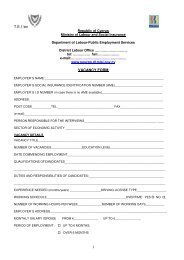

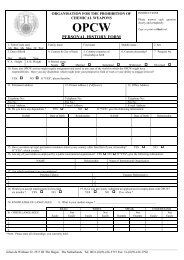
![Hadjimichael[1].pdf](https://img.yumpu.com/33937965/1/190x135/hadjimichael1pdf.jpg?quality=85)

